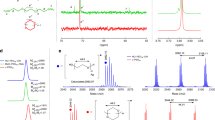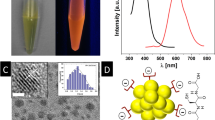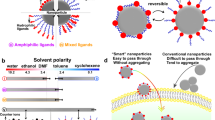Abstract
We describe a simple and versatile scheme to prepare a series of poly(ethylene glycol)-based bidentate ligands that permit strong interactions with colloidal semiconductor nanocrystals (quantum dots, QDs) and gold nanoparticles (AuNPs) alike and promote their dispersion in aqueous solutions. These ligands are synthesized by coupling poly(ethylene glycol)s of various chain length to thioctic acid, followed by ring opening of the 1,2-dithiolane moiety to create a bidentate thiol anchoring group with enhanced affinity for CdSe-ZnS core-shell QDs. These ligands provide a straightforward means of preparing QDs and AuNPs that exhibit greater resistance to environmental changes, facilitating their effective use in bioassays and live cell imaging.
This is a preview of subscription content, access via your institution
Access options
Subscribe to this journal
Receive 12 print issues and online access
$259.00 per year
only $21.58 per issue
Buy this article
- Purchase on Springer Link
- Instant access to full article PDF
Prices may be subject to local taxes which are calculated during checkout





Similar content being viewed by others
References
Mattoussi, H., Kuno, M.K., Goldman, E.R., Anderson, G.P. & Mauro, J.M. Colloidal semiconductor quantum dot conjugates in biosensing. In Optical Biosensors: Present and Future (eds. Ligler, F.S. and Rowe Taitt, C.A.) 537–569 (Elsevier, Amsterdam, The Netherlands, 2002).
Åkerman, M.E., Chan, W.C.W., Laakkonen, P., Bhatia, S.N. & Ruoslahti, E. Nanocrystal targeting in vivo . Proc. Natl. Acad. Sci. 99, 12617–12621 (2002).
Dubertret, B. et al. In vivo imaging of quantum dots encapsulated in phospholipid micelles. Science 298, 1759–1762 (2002).
Wu, X. et al. Immunofluorescent labeling of cancer marker Her2 and other cellular targets with semiconductor quantum dots. Nature Biotechnol. 21, 41–46 (2003).
Jaiswal, J.K., Mattoussi, H., Mauro, J.M. & Simon, S.M. Long-term multiple color imaging of live cells using quantum dot bioconjugates. Nat. Biotechnol. 21, 47–51 (2003).
Goldman, E.R. et al. Conjugation of luminescent quantum dots with antibodies using an engineered adaptor protein to provide new reagents for fluoroimmunoassays. Anal. Chem. 74, 841–847 (2002).
Medintz, I.L. et al. Self-assembled biosensors based on quantum dot FRET donors. Nat. Mater. 2, 630–638 (2003).
Goldman, E.R. et al. Multiplexed toxin analysis using four colors of quantum dot fluororeagents. Anal. Chem. 76, 684–688 (2004).
Gao, X., Cui, Y., Levenson, R.M., Chung, L.W.K. & Nie, S. In vivo cancer targeting and imaging with semiconductor quantum dots. Nat. Biotechnol. 22, 969–976 (2004).
Gerion, D. et al. Sorting fluorescent nanocrystals with DNA. J. Am. Chem. Soc. 124, 7070–7074 (2002).
Gerion, D. et al. Room-temperature single-nucleotide polymorphism and multiallele DNA detection using fluorescent nanocrystals and microarrays. Anal. Chem. 75, 4766–4772 (2003).
Kim, S. et al. Near-infrared fluorescent type II quantum dots for sentinel lymph node mapping. Nat. Biotechnol. 22, 93–97 (2004).
Bruchez, M. Jr., Moronne, M., Gin, P., Weiss, S. & Alivisatos, A.P. Semiconductor nanocrystals as fluorescent biological labels. Science 281, 2013–2016 (1998).
Chan, W.C.W. & Nie, S. Quantum dot bioconjugates for ultrasensitive nonisotopic detection. Science 281, 2016–2018 (1998).
Mattoussi, H. et al. Self-assembly of CdSe–ZnS quantum dot bioconjugates using an engineered recombinant protein. J. Am. Chem. Soc. 122, 12142–12150 (2000).
Murray, C.B., Norris, D.J. & Bawendi, M.G. Synthesis and characterization of nearly monodisperse CdE (E=S, Se, Te) semiconductor nanocrystallites. J. Am. Chem. Soc. 115, 8706–8715 (1993).
Hines, M.A. & Guyot-Sionnest, P. Synthesis and characterization of strongly luminescing ZnS-capped CdSe nanocrystals. J. Phys. Chem. 100, 468–471 (1996).
Dabbousi, B.O. et al. (CdSe)ZnS core-shell quantum dots: synthesis and characterization of a size series of highly luminescent nanocrystallites. J. Phys. Chem. B 101, 9463–9475 (1997).
Peng, Z.A. & Peng, X. Formation of high-quality CdTe, CdSe, and CdS nanocrystals using CdO as precursor. J. Am. Chem. Soc. 123, 183–184 (2001).
Peng, Z.A. & Peng, X. Nearly monodisperse and shape-controlled CdSe nanocrystals via alternative routes: nucleation and growth. J. Am. Chem. Soc. 124, 3343–3353 (2002).
Al-Jamal, W.T. et al. Lipid-quantum dot bilayer vesicles enhance tumor cell uptake and retention in vitro and in vivo . ACS Nano 2, 408–418 (2008).
Choi, H.S. et al. Renal clearance of quantum dots. Nature Biotechnol. 25, 1165–1170 (2007).
Pinaud, F., King, D., Moore, H.-P. & Weiss, S. Bioactivation and cell targeting of semiconductor CdSe/ZnS nanocrystals with phytochelatin-related peptides. J. Am. Chem. Soc. 126, 6115–6123 (2004).
Pons, T., Uyeda, H.T., Medintz, I.L. & Mattoussi, H. Hydrodynamic dimensions, electrophoretic mobility, and stability of hydrophilic quantum dots. J. Phys. Chem. B 110, 20308–20316 (2006).
Medintz, I.L., Uyeda, H.T., Goldman, E.R. & Mattoussi, H. Quantum dot bioconjugates for imaging, labelling and sensing. Nat. Mater. 4, 435–446 (2005).
Voura, E.B., Jaiswal, J.K., Mattoussi, H. & Simon, S.M. Tracking metastatic tumor cell extravasation with quantum dot nanocrystals and fluorescence emission-scanning microscopy. Nat. Med. 10, 993–998 (2004).
Jaiswal, J.K., Goldman, E.R., Mattoussi, H. & Simon, S.M. Use of quantum dots for live cell imaging. Nat. Methods 1, 73–78 (2004).
Uyeda, H.T., Medintz, I.L., Jaiswal, J.K., Simon, S.M. & Mattoussi, H. Synthesis of compact mutidentate ligands to prepare stable hydrophilic quantum dot fluorophores. J. Am. Chem. Soc. 127, 3870–3878 (2005).
Mei, B.C. et al. Modular poly(ethylene glycol) ligands for biocompatible semiconductor and gold nanocrystals with extended pH and ionic stability. J. Mater. Chem. 18, 4949–4958 (2008).
Medintz, I.L. et al. Proteolytic activity monitored by fluorescence resonance energy transfer through quantum-dot–peptide conjugates. Nat. Mater. 5, 581–589 (2006).
Qu, L., Peng, Z.A. & Peng, X. Alternative routes toward high quality CdSe nanocrystals. Nano Lett. 1, 333–337 (2001).
Clapp, A.R., Goldman, E.R. & Mattoussi, H. Capping of CdSe-ZnS quantum dots with DHLA and subsequent conjugation with proteins. Nat. Protoc. 1, 1258–1267 (2006).
Turkevich, J., Stevenson, P.C. & Hillier, J. A study of the nucleation and growth processes in the synthesis of colloidal gold. Discuss. Faraday Soc. 11, 55–75 (1951).
Grabar, K.C., Freeman, R.G., Hommer, M.B. & Natan, M.J. Preparation and characterization of Au colloid monolayers. Anal. Chem. 67, 735–743 (1995).
Susumu, K. et al. Enhancing the stability and biological functionalities of quantum dots via compact multifunctional ligands. J. Am. Chem. Soc. 129, 13987–13996 (2007).
Sapsford, K.E. et al. Kinetics of metal-affinity driven self-assembly between proteins or peptides and CdSe-ZnS quantum dots. J. Phys. Chem. C 111, 11528–11538 (2007).
Leatherdale, C.A., Woo, W.-K., Mikulec, F.V. & Bawendi, M.G. On the absorption cross section of CdSe nanocrystal quantum dots. J. Phys. Chem. B 106, 7619–7622 (2002).
Clapp, A.R. et al. Fluorescence resonance energy transfer between quantum dot donors and dye-labeled protein acceptors. J. Am. Chem. Soc. 126, 301–310 (2004).
Clapp, A.R. et al. Quantum dot-based multiplexed fluorescence resonance energy transfer. J. Am. Chem. Soc. 127, 18212–18221 (2005).
Clapp, A.R., Medintz, I.L. & Mattoussi, H. Förster resonance energy transfer investigations using quantum-dot fluorophores. ChemPhysChem 7, 47–57 (2006).
Pons, T., Medintz, I.L., Wang, X., English, D.S. & Mattoussi, H. Solution-phase single quantum dot fluorescence resonance energy transfer. J. Am. Chem. Soc. 128, 15324–15331 (2006).
Acknowledgements
We acknowledge NRL, Office of Naval Research (ONR), the Army Research Office (ARO) and the CB Directorate/Physical S&T Division (DTRA) for financial support. We thank Dr Horn-Bond Lin for assistance with the FTIR spectra.
Author information
Authors and Affiliations
Corresponding author
Rights and permissions
About this article
Cite this article
Mei, B., Susumu, K., Medintz, I. et al. Polyethylene glycol-based bidentate ligands to enhance quantum dot and gold nanoparticle stability in biological media. Nat Protoc 4, 412–423 (2009). https://doi.org/10.1038/nprot.2008.243
Published:
Issue Date:
DOI: https://doi.org/10.1038/nprot.2008.243
This article is cited by
-
Quantum dot-enabled membrane-tethering and enhanced photoactivation of chlorin-e6
Journal of Nanoparticle Research (2021)
-
Efficient targeted tumor imaging and secreted endostatin gene delivery by anti-CD105 immunoliposomes
Journal of Experimental & Clinical Cancer Research (2018)
-
Folic acid and its derivatives for targeted photodynamic therapy of cancer
Russian Chemical Bulletin (2017)
-
Preparation of compact biocompatible quantum dots using multicoordinating molecular-scale ligands based on a zwitterionic hydrophilic motif and lipoic acid anchors
Nature Protocols (2015)
Comments
By submitting a comment you agree to abide by our Terms and Community Guidelines. If you find something abusive or that does not comply with our terms or guidelines please flag it as inappropriate.



